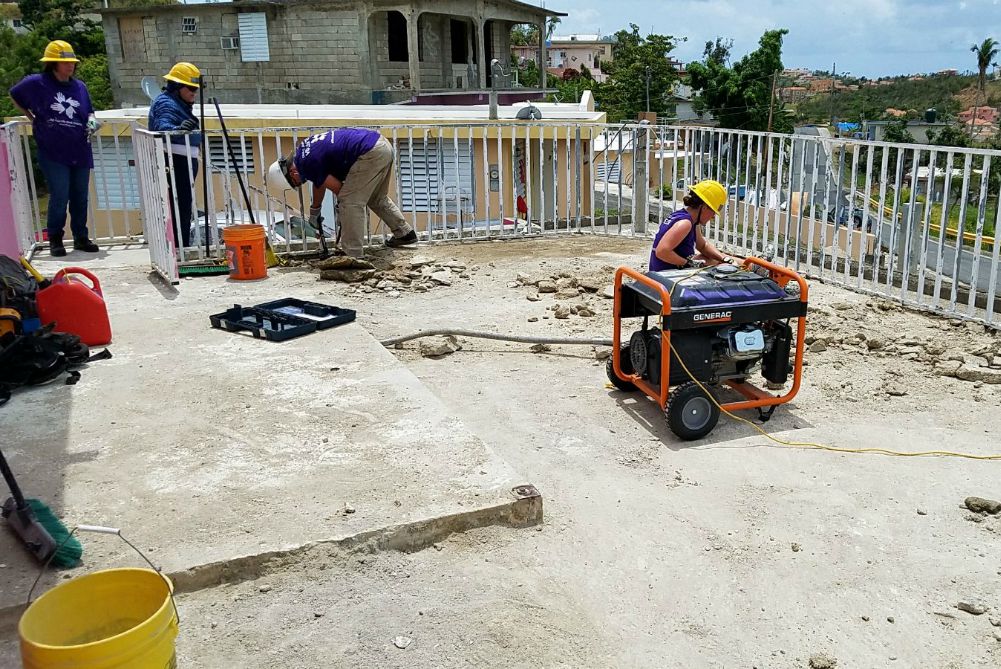
During an April mission trip, Catholics Care volunteers from the Diocese of Brooklyn, New York, worked to repair roofs and remove mold from homes in Yabucoa, Puerto Rico, that were impacted by Hurricane Maria. (Diocese of Brooklyn, New York)
When Hurricane Maria ripped through the Caribbean in September 2017, it transformed tropical paradises into disaster zones in mere days. It also cut off an economic life vein for many of the impacted islands: tourism.
Footage of Maria's destruction, as well as the wake of Hurricane Irma a week earlier and other storms that have struck popular vacation destinations, can leave potential visitors wondering when, or if at all, it's appropriate to travel to an area regrouping from a weather-related disaster.
Is it all right to relax while others work to rebuild?
The 2017 hurricane season was devastating, the fifth most active on record. Warming ocean temperatures and rising seas as a result of climate change could make more intense, damaging storms more the norm than outliers.
The U.S. territory of Puerto Rico faced two category 4 storms in Irma and Maria. The latter, bringing 155 mph winds, knocked out all power and most cellular service across the island, shut down 16,000 miles of roads, brought upwards of $100 billion in damages, including 166,000 impacted homes, and is estimated to have resulted in the deaths of 2,975 people — a death toll on par with the Sept. 11, 2001, terrorist attacks and higher than Hurricane Katrina in 2005, and making it the nation's deadliest weather-related disaster in a century.
Advertisement
The impact extended to a number of islands throughout the Caribbean, including the U.S. Virgin Islands, Dominica, Barbuda and St. Martin. All were "greatly affected," said Eric LeCompte, executive director of Jubilee USA, an interfaith alliance of non-profit organizations seeking to address structural and financial causes of poverty and inequality. The financial toll was even worse for islands whose economies are largely reliant on tourism.
"It's a double whammy when natural disasters strike in these areas because not only is an island or a country struggling to recover, they're also wrestling with losing their main form of income," LeCompte said.
In terms of total gross domestic product, travel and tourism is an essential component of the economies of Dominica (38 percent) and Antigua and Barbuda (52 percent) — each struck by Maria and Irma, respectively, at category 5 intensities. In the British Virgin Islands, it's 98 percent. For Puerto Rico, tourism accounts for 7 percent of its economy.
As a whole, tourism in the Caribbean makes up a larger percentage of total GDP (15 percent) and employment (13.8 percent) than any other region in the world, according to a 2018 economic impact report from the World Travel and Tourism Council. A separate report described the "devastatingly severe" impact the 2017 hurricane season had on tourism, for both islands directly hit and those not in its path, which accounted for two-thirds of the region. The report estimated a cumulative loss of $741 million, 826,000 visitors and 11,000 jobs as a result of the hurricanes.
Making matters worse is that a number of islands hit by hurricanes were countries and territories already facing financial and debt crises, LeCompte said. That left many ill-prepared to fortify infrastructure for a major storm, much less deal with the aftermath.
"These islands were already in a very tough spot before the hurricanes came. And now all of those problems have been compounded," he said.
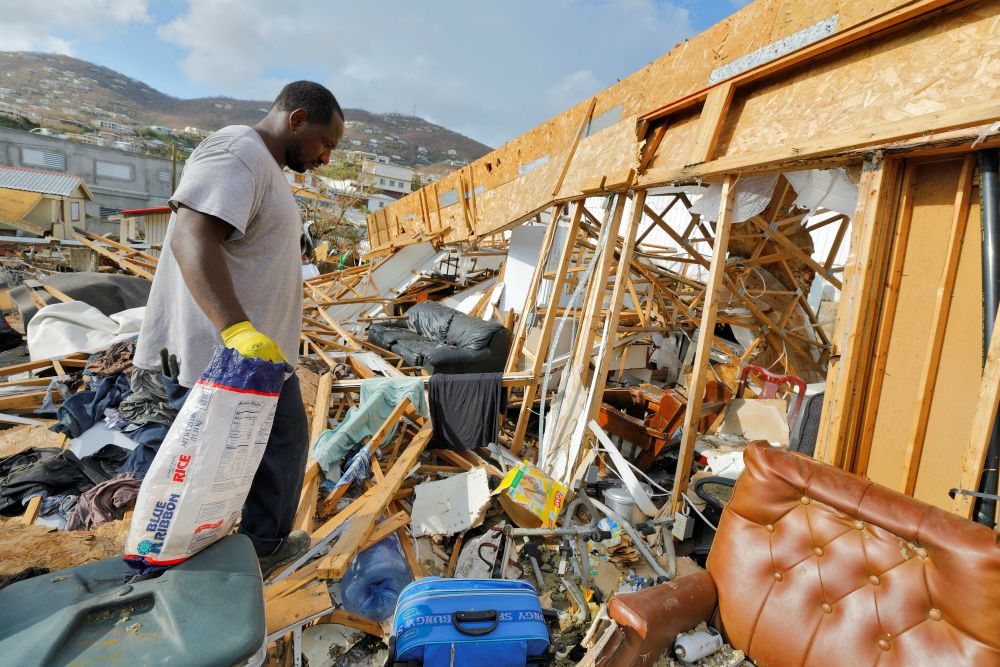
A man looks through the debris of his destroyed home in the aftermath of Hurricane Irma Sept. 17, 2017, in St. Thomas in the U.S. Virgin Islands. (CNS/Reuters/Jonathan Drake)
In the case of Puerto Rico, the U.S. territory was dealing with major economic challenges from a debt crisis that stemmed back to Congress phasing out pharmaceutical-related tax breaks in the mid-1990s; by the time the incentives were fully repealed in 2006, 80,000 high-paying jobs had been lost and Puerto Rico entered into a deep recession. In 2017, the island, with a population of 3.4 million people, had a poverty rate of roughly 44 percent — more than double Mississippi, which at 19.8 percent led all 50 states, according to the U.S. Census Bureau. Nearly six-in-10 Puerto Rican children live in poverty. It was into those conditions that Hurricane Maria arrived.
More than a year later, Puerto Rico's recovery continues.
While most of the major debris brought by the hurricanes has been cleared and power was fully restored as of July, power outages continue in some parts, LeCompte said, and electrical access is more intermittent the farther you travel into the island's more rural regions. Those areas also face clean water issues and have older buildings and structures still dotted with the government-provided blue tarps.
While the island was less reliant on tourism than others, it too took a hit, with estimated losses of 202,000 visitors and $113.4 million in spending, according to the World Travel and Tourism Council report. In September, Puerto Rico began a campaign actively recruiting tourists to come back, that its "welcome" sign was re-illuminated.
"The best way to support the island is by visiting," said Brad Dean, CEO of Discover Puerto Rico, a non-profit organization formed in July to promote the island.
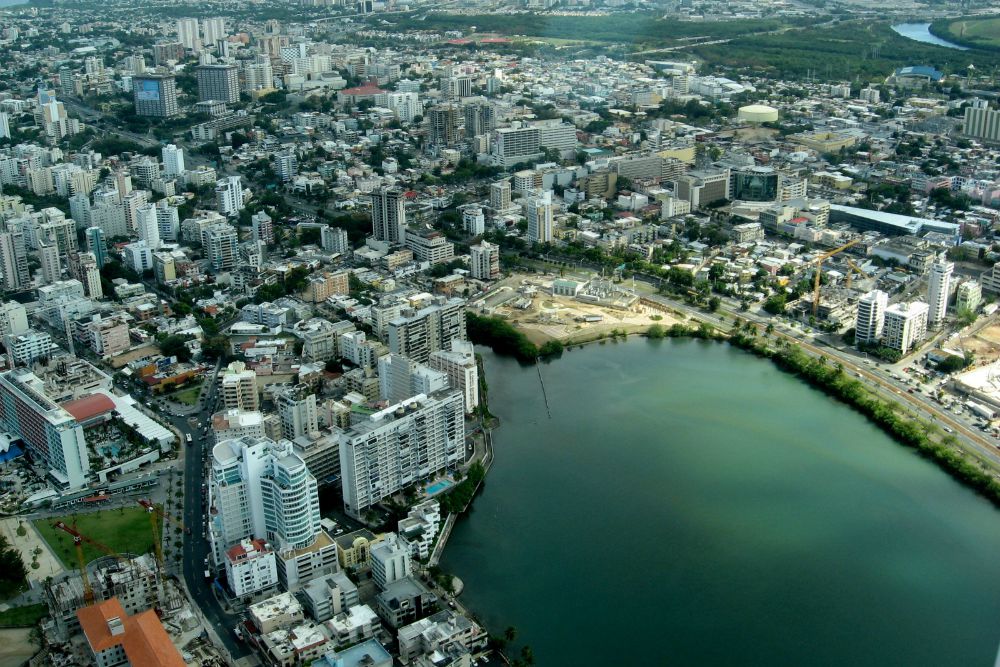
Aerial view of San Juan Puerto Rico, March 2008 (Wikimedia Commons/E. Thorson)
Dean noted that 135 hotels have reopened, with more than 100 flights arriving daily. In addition, the island's cruise ship and convention sectors are growing. "We’ve made a remarkable comeback," he said, attributing the progress on tourism, a "vital" part of the island's recovery, to "the resiliency and strength of our people."
Before more traditional tourists began arriving, it was relief workers and humanitarian organizations that occupied rooms at some of the island's resorts and hotels. Catholic Charities USA led the church's response in Puerto Rico and the U.S. Virgin Islands, while Catholic Relief Services coordinated efforts outside the U.S. In addition, volunteer-based relief organizations like All Hands and Hearts, Team Rubicon and St. Bernard Project are often among the first groups that arrive, and some of the last to leave, after disasters strike.
In April, Catholics Care, a team of volunteers from the Diocese of Brooklyn, New York, joined All Hands and Hearts in their work in Yabucoa, Puerto Rico, a seaside community on the southeast corner of the island where Hurricane Maria first made landfall.
For a week, the group of 15 volunteers spent their days on tops of roofs, stripping off the old tar before applying a new "peanut-buttery thick" layer of white tar, and inside homes chiseling away mold from the walls and ceilings. In between the work, grueling at times under hot temps and in hazmat suits, the Catholics Care team listened as people described their struggles, including the lack of available work in part due to shut-down hotels.
Adriana Rodriguez, acting press secretary for the Brooklyn Diocese who organized the trip, had considered a vacation with her family to the island two months earlier, but ultimately canceled it.
"I just didn't feel comfortable going," she said.
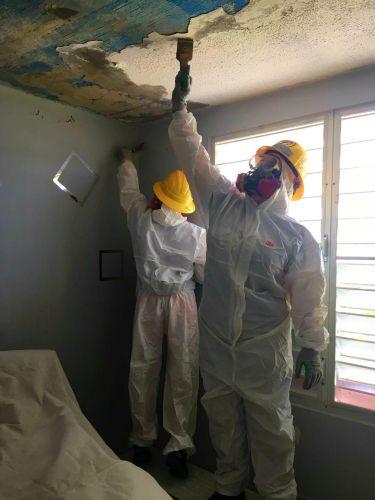
Catholics Care volunteers, April 2018 (Diocese of Brooklyn, New York)
While images of a recovering region can leave some skittish of traveling there, LeCompte said it's important to remember that the storms, earthquakes or other destructive events often don't usher in impoverished conditions, but rather exacerbate inequality that existed beforehand. Given that, he suggested travelers shouldn't hesitate to travel to these destinations, "and even choose these areas, because they are so in need of income."
In spite of challenging circumstances, whether brought by extreme weather or economic inequality, the Jubilee USA official said people he and others have met in Puerto Rico and elsewhere in the Caribbean continually invite them to come back and visit again — and to bring their families. To help overcome any feelings of guilt, he encourages tourists to experience the local culture outside of beach resorts, to better learn about local life, challenges and all.
"People are very hospitable and want to be able to teach and show people what's special about the place that they live," he said.
As the Catholics Care crew worked on houses and roofs in Yabucoa, the residents prepared meals for the volunteers, on several occasions serving community meals in nearby parks.
"They were so grateful, these people. All they wanted to do with cook for us," said Rodriguez, adding "food is love in that culture."
The idea of "voluntourism" has become more popular in recent years, with millions of people annually planning trips with an aim toward helping others. Catholics Care have explored another trip back to Puerto Rico, which would be their third, having also worked in Houston in the months following Hurricane Harvey.
And while Rodriguez ended up canceling her 50th birthday trip to Puerto Rico, she hopes to travel there early next year with her family: to vacation, but also to volunteer to help the ongoing recovery.
"I feel like it's great for a family to do because you're teaching your kids about helping the people who need help. Well, what better example of our faith than that?" she said.
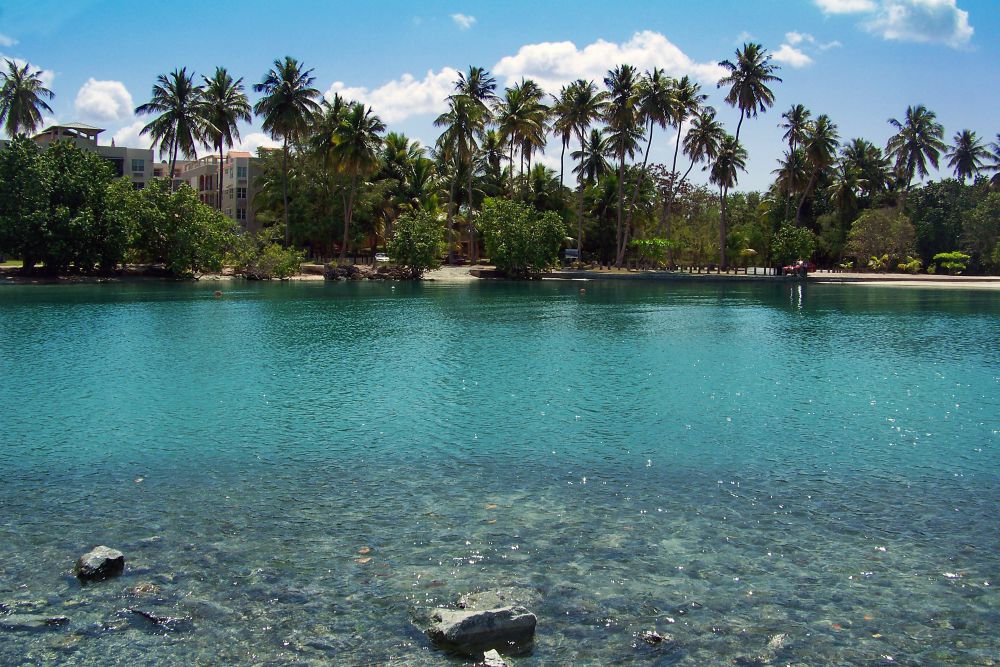
Ostiones beach, Puerto Rico, March 2009 (Wikimedia Commons/Jerjes Medina Albino)
[Brian Roewe is an NCR staff writer. His email is broewe@ncronline.org. Follow him on Twitter @brianroewe.]




